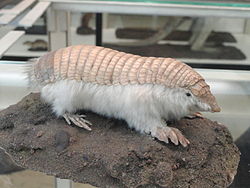| Chlamyphoridae Temporal range: Middle Eocene to present | |
|---|---|
 | |
| Southern three-banded armadillo (Tolypeutes matacus) | |
 | |
| Illustration of a skeleton of Doedicurus clavicaudatus | |
| Scientific classification | |
| Kingdom: | Animalia |
| Phylum: | Chordata |
| Class: | Mammalia |
| Order: | Cingulata |
| Family: | Chlamyphoridae Bonaparte, 1850 |
| Type genus | |
| Chlamyphorus Harlan, 1825 | |
| Subfamilies | |
 | |

Chlamyphoridae is a family of cingulate mammals. While glyptodonts have traditionally been considered stem-group cingulates outside the group that contains modern armadillos, there had been speculation that the extant family Dasypodidae could be paraphyletic based on morphological evidence. [1] [2] [3] [4] In 2016, an analysis of Doedicurus mtDNA found it was, in fact, nested within the modern armadillos as the sister group of a clade consisting of Chlamyphorinae and Tolypeutinae. [5] [6] For this reason, all extant armadillos but Dasypus were relocated to a new family. The genus name comes from Ancient Greek χλαμύς (khlamús), meaning "cloak", and φόρος (phóros), "bearing".